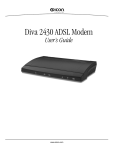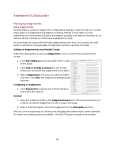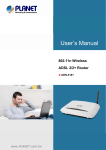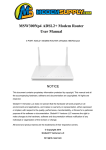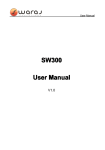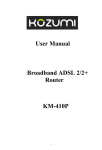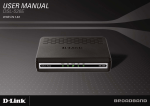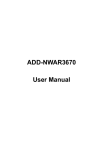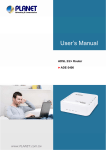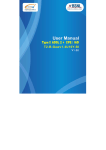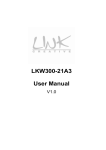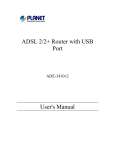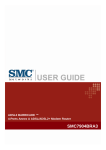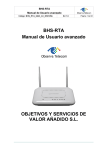Download SW200 User Manual - Swarajonline.com
Transcript
User Manual SW200 User Manual V1.0 User Manual Contents 1 Introduction......................................................................................................................... 1 1.1 Safety Precautions............................................................................................... 1 1.2 LEDs and Interfaces............................................................................................ 2 1.3 System Requirements......................................................................................... 3 1.4 Features................................................................................................................ 4 2 Hardware Installation.........................................................................................................6 3 About the Web Configuration........................................................................................... 9 3.1 Access the Router................................................................................................ 9 3.2 Status...................................................................................................................10 3.3 Wizard................................................................................................................. 12 3.4 Setup................................................................................................................... 18 3.4.1 WAN Configuration...............................................................................18 3.4.1.1 WAN......................................................................................... 18 3.4.1.2 ATM Setting............................................................................. 24 3.4.1.3 ADSL Setting........................................................................... 25 3.4.2 LAN........................................................................................................ 25 3.4.2.1 LAN........................................................................................... 25 3.4.2.2 DHCP....................................................................................... 27 3.4.2.3 DHCP Static.............................................................................32 3.4.3 WLAN.....................................................................................................33 3.4.3.1 Basic Settings..........................................................................33 3.4.3.2 Security.................................................................................... 35 3.4.3.3 Multi-BSSID............................................................................. 38 3.4.3.4 Access Control........................................................................ 40 3.4.3.5 Advanced................................................................................. 40 3.4.3.6 WPS..........................................................................................42 3.5 Advanced............................................................................................................ 44 3.5.1 Route......................................................................................................44 3.5.1.1 Static Route............................................................................. 44 3.5.1.2 RIP............................................................................................ 45 3.5.2 NAT.........................................................................................................47 3.5.2.1 DMZ.......................................................................................... 47 i User Manual 3.5.2.2 Virtual Server...........................................................................48 3.5.2.3 ALG........................................................................................... 50 3.5.2.4 NAT Exclude IP....................................................................... 50 3.5.2.5 Port Trigger.............................................................................. 51 3.5.2.6 FTP ALG PORT.......................................................................53 3.5.2.7 Nat IP Mapping........................................................................53 3.5.3 QoS........................................................................................................ 54 3.5.4 CWMP....................................................................................................57 3.5.5 Port Mapping.........................................................................................59 3.5.6 Others.................................................................................................... 64 3.5.6.1 Bridge Setting.......................................................................... 64 3.5.6.2 Client Limit............................................................................... 65 3.5.6.3 Others.......................................................................................65 3.6 Service.................................................................................................................66 3.6.1 IGMP...................................................................................................... 66 3.6.1.1 IGMP Proxy............................................................................. 66 3.6.2 UPnP......................................................................................................67 3.6.3 SNMP.....................................................................................................68 3.6.4 DNS........................................................................................................69 3.6.4.1 DNS.......................................................................................... 69 3.6.5 DDNS..................................................................................................... 70 3.6.6 FTP Server............................................................................................ 71 3.7 Firewall................................................................................................................ 71 3.7.1 MAC Filter..............................................................................................71 3.7.2 IP/Port Filter.......................................................................................... 72 3.7.2.1 IP/Port Filter.............................................................................72 3.7.3 URL Filter...............................................................................................73 3.7.4 ACL.........................................................................................................74 3.7.4.1 ACL........................................................................................... 74 3.7.5 DoS........................................................................................................ 78 3.8 Maintenance....................................................................................................... 80 3.8.1 Update................................................................................................... 80 3.8.1.1 Firmware Update.................................................................... 80 3.8.1.2 Backup/Restore.......................................................................81 ii User Manual 3.8.2 Password...............................................................................................81 3.8.3 Reboot................................................................................................... 82 3.8.4 Time........................................................................................................83 3.8.5 Log..........................................................................................................85 3.8.6 Diagnostics............................................................................................85 4 Q&A................................................................................................................................... 87 iii User Manual 1 Introduction The device supports multiple line modes. It provides four 10/100 base-T Ethernet interfaces at the user end. The device provides high-speed ADSL2/2+ broadband connection to the Internet or Intranet for high-end users, such as net bars and office users. It provides high performance access to the Internet. The device supports WLAN access, such as WLAN AP or WLAN device, to the Internet. It complies with IEEE 802.11, 802.11b/g/n specifications, WEP, WPA, and WPA2 security specifications. autions 1.1 Safety Prec Precautions Follow the following instructions to prevent the device from risks and damage caused by fire or electric power: � Use volume labels to mark the type of power. � Use the power adapter packed within the device package. � Pay attention to the power load of the outlet or prolonged lines. An overburden power outlet or damaged lines and plugs may cause electric shock or fire accident. Check the power cords regularly. If you find any damage, replace it at once. � Proper space left for heat dissipation is necessary to avoid damage caused by overheating to the device. The long and thin holes on the device are designed for heat dissipation to ensure that the device works normally. Do not cover these heat dissipation holes. � Do not put this device close to a place where a heat source exists or high temperature occurs. Avoid the device from direct sunshine. � Do not put this device close to a place where it is over damp or watery. Do not spill any fluid on this device. � Do not connect this device to any PCs or electronic products, unless our customer engineer or your broadband provider instructs you to do this, because any wrong connection may cause power or fire risk. � Do not place this device on an unstable surface or support. 1 User Manual 1.2 LEDs and Interfaces Front Panel The following table describes the LEDs of the device. LEDs Power DSL INT WiFi LAN1~4 Status Description On The initialization of the device is successful. Off The device is powered off. On DSL link up / link synchronized. Off Link disconnection. Blinking Link training / DSL link not synchronized. On Successful PPP session. Blinking Failure PPP session (1 minute after link up). Off Before DSL link up. On The WLAN connection has been activated. Off The WLAN connection is not activated. On The LAN connection is normal and activated. Off The LAN interface is disconnected. Blinking WPS is triggered, and is waiting for client to negotiate. Off WPS is idle. WPS Rear Panel 2 User Manual Figure 1 The following table describes the interfaces and buttons of the device: Interface Description Reset Reset to the factory default configuration. Keep the device powered on, and insert a needle into the hole for 3 seconds, then release it. The device is reset to the factory default configuration. ON/OFF Power switch, power on or power off the device. Power Power interface, for connecting to the power adapter of DC 12V, 0.5A. LAN1~4 RJ45 interface, for connecting to the Ethernet interface of a PC or the Ethernet devices through an Ethernet cable. DSL RJ11 interface, for connecting to the ADSL interface or a splitter through a telephone cable. � Press the button between 1s and 5s to enable WLAN function. WLAN/WPS � Press the button for more than 5s to enable WPS (Wi-Fi Protected Setup) function. 1.3 System Requirements Recommended system requirements are as follows: � Service subscriber � 10 Base T/100 Base T Ethernet card � Hub or switch (attached to several PCs through one of Ethernet interfaces on the device) � Operating system: Windows 98 SE, Windows 2000, Windows ME, Windows XP, Windows Vista, Window 7 � Internet Explorer V5.0 or higher, Netscape V4.0 or higher, or FireFox 1.5 or higher 3 User Manual 1.4 Features The device supports the following features: Various line modes (line auto-negotiation) � External PPPoE dial-up access � Internal PPPoE/PPPoA dial-up access � 1483B/1483R/MER access � Multiple PVCs (eight at most) � A single PVC with multiple sessions � Multiple PVCs with multiple sessions � Auto PVC � DHCP server � IPv4/IPv6 � NAT/NAPT � ALG � TR-069 � SNMP � Static route � Firmware upgrading through Web, TFTP, or FTP � Resetting to the factory defaults through Reset button or Web � DNS relay � Virtual server � Two-level passwords and usernames � Web interface � Telnet CLI � System status display � PPP session PAP/CHAP � IP/Port filter � Remote access control � Line connection status test � Remote management (Telnet; HTTP ) � Backup and restoration of configuration file � IP quality of service (QoS) � Universal plug and play (UPnP) � 4 User Manual � WLAN with high-speed data transmission rate, compatible with IEEE 802.11b/g/n, 2.4 GHz compliant equipment 5 User Manual 2 Hardware Installation Step 1 Connect the DSL interface of the router and the Modem interface of the splitter through a telephone cable. Connect the phone to the Phone interface of the splitter through a cable. Connect the incoming line to the Line interface of the splitter. The splitter has three interfaces: � Line Line: Connect to a wall phone jack (RJ-11 jack) � Modem Modem: Connect to the ADSL jack of the device � Phone Phone: Connect to a telephone set. Step 2 Connect the LAN interface of the modem with the network card of the PC through an Ethernet line (MDI/MDIX). Note: Use twisted-pair cables to connect with the hub or Switch. Step 3 Plug the power adapter to the wall outlet and then connect the other end of it to the Power interface of the modem. Connection 1 Figure1 displays the application diagram for the connection of the modem, PC, splitter, and telephone sets, when no telephone set is placed before a splitter. This type of connection is recommended. 6 User Manual Figure 2 Connection diagram (no telephone set is placed before the splitter) Connection 2 Figure 2 displays the connection when the telephone set is placed before a splitter. 7 User Manual Figure 3 Connection diagram (a telephone set is placed before the splitter) Note: In actual application, it is recommended to following connection 1. When connection 2 is used, the filter must be installed close to the telephone cable. See Figure2. Do not use the splitter to replace the filter. Installing a telephone directly before the splitter may lead to a failure of connection between the modem and the device of LAN side, or cannot access into the Internet, or slow the connection speed. If you really need to add a telephone set before the splitter, you have to add a micro filter before connecting to a telephone set. Do not connect several telephones before the splitter. Do not connect several telephones with the micro filter. 8 User Manual 3 ion About the Web Configurat Configuration This chapter describes how to configure the router by using the Web-based configuration utility. 3.1 Access the Router The following is the detailed description of accessing the router for the first time. Configure the IP address of the PC as 192.168.1.X (2~254), Subnet Mask as 255. 255.255.0. Open the Internet Explorer (IE) browser and enter http://192.168.1.1 http://192.168.1.1.In the Login page that is displayed, enter the username and password. � The username and password of the super user are admin and admin � The username and password of the common user are user and user If you log in as a super user, you will see the Device Info page as shown below appears. You can check the basic settings of the modem, such as firmware version, upstream speed, downstream speed, LAN MAC address, LAN IP address, DHCP server status. You can also view the basic status of WAN and DNS server. 9 User Manual 3.2 Status 10 User Manual The tab Status contains Device Info and Statistics Statistics. Click Status > Device Info > ADSL ADSL, the following page appears. You can see the router settings such as the Adsl Line Status, Vendor ID and Firmware Version. Click Status > Statistics Statistics, the following page appears. In this page, you can view the statistics of each network port. 11 User Manual 3.3 Wizard In the navigation bar, click Wizard Wizard. The tab Wizard only contains Wizard Wizard.. 12 User Manual 1) Change the VPI or VCI values which are used to define a unique path for your connection. If you have been given specific settings for this to configuration, type in the correct values assigned by your ISP. 2) Please select the Connection Type given by your ISP. 13 User Manual 3) Here we use PPPoE as an example. Enter the Username, Password and Confirm Password given by your ISP, and then click Next. 4) On the Wireless screen, we use the default SSID, select a Mode. Set a Password or select Disable Security(Disable Security is not recommended.), and then click Next to continue. 14 User Manual 5) On this page, please confirm all parameters. Click Prev to modify or click the Apply Changes button to save your configuration. 15 User Manual 6) You will see the Complete screen below. 16 User Manual 17 User Manual 3.4 Setup In the navigation bar, click Setup Setup. The tab Setup contains WAN, LAN and WLAN. 3.4.1 3.4.1.1 WAN Configuration WAN Choose Setup > WAN > WAN and the page shown in the following figure appears. In this page, you can configure WAN interface of your router. 18 User Manual The following table describes the parameters of this page. Field Description Default Route Selection You can select Auto or Specified Specified. VPI The virtual path between two points in an ATM network, ranging from 0 to 255. VCI The virtual channel between two points in an ATM network, ranging from 32 to 65535 (1 to 19 User Manual Field Description 31 are reserved for known protocols) Encapsulation You can choose LLC and VC-Mux VC-Mux. Channel Mode You can choose 1483 Bridged Bridged, 1483 MER MER, PPPoE PPPoE, PPPoA PPPoA, 1483 Routed or IPoA IPoA. Enable NAPT Select it to enable Network Address Port Translation (NAPT) function. If you do not select it and you want to access the Internet normally, you must add a route on the uplink equipment. Otherwise, the access to the Internet fails. Normally, it is enabled. Enable IGMP You can enable or disable Internet Group Management Protocol (IGMP) function. IP Protocol Select this interface support ipv4/ipv6, ipv4 or ipv6. PPP Settings User Name Enter the correct user name for PPP dial-up, which is provided by your ISP. Password Enter the correct password for PPP dial-up, which is provided by your ISP. Type You can choose Continuous Continuous, Connect on Demand or Manual Manual. Idle Time (min) If set the type to Connect on Demand Demand, you need to enter the idle timeout time. Within the preset minutes, if the router does not detect the flow of the user continuously, the router automatically disconnects the PPPoE connection. WAN IP Settings Type You can choose Fixed IP or DHCP DHCP. � If select Fixed IP IP, you should enter the local IP address, remote IP address and subnet mask. � If select DHCP DHCP, the router is a DHCP 20 User Manual Field Description client, the WAN IP address is assigned by the remote DHCP server. Local IP Address Enter the IP address of WAN interface provided by your ISP. Netmask Enter the subnet mask of the local IP address. Unnumbered Select this checkbox to enable IP unnumbered function. IPv6 WAN Setting Set ipv6 wan setting if this interface support ipv6 Address Mode Select this interface support Slaac or Static to generate wan ipv6 addresses. Enable DHCPv6 Client Enable or disable dhcpv6 client on this interface, if enable, user can specify if the dhcpv6 client request Address or request Prefix. Add After configuring the parameters of this page, click it to add a new PVC into the Current ATM VC Table Table. Modify Select a PVC in the Current ATM VC Table Table, then modify the parameters of this PVC. After finishing, click it to apply the settings of this PVC. Delete Select a PVC in the Current ATM VC Table, and then click Delete to delete it Current ATM VC Table This table shows the existed PVCs. It shows the interface name, channel mode, VPI/VCI, encapsulation mode, local IP address, remote IP address and other information. The maximum item of this table is eight. After proper settings, click Add and the following page appears. 21 User Manual Click in the PPPoE mode, the page shown in the following figure appears. In this page, you can configure parameters of this PPPoE PVC. The following table describes the parameters and buttons of this page. 22 User Manual Field Description Protocol It displays the protocol type used for this WAN connection. ATM VCC The ATM virtual circuit connection assigned for this PPP interface (VPI/VCI). Login Name The user name provided by your ISP. Password The password provided by your ISP. Authentication Method You can choose AUTO AUTO, PAP or CHAP CHAP. Connection Type You can choose Continuous Continuous, Connect on d or Manual Deman Demand Manual. Idle Time (s) If choose Connect on Demand Demand, you need to enter the idle timeout time. Within the preset minutes, if the router does not detect the flow of the user continuously, the router automatically disconnects the PPPoE connection. Bridge You can select Bridged Ethernet Ethernet, Bridged PPPoE or Disable Bridge Bridge. AC-Name The accessed equipment type. Service-Name The service name. 802.1q You can select Disable or Enable Enable. After enable it, you need to enter the VLAN ID. The value ranges from 1 to 4095. Apply Changes Click it to save the settings of this page temporarily. Return Click it to return to the Channel Configuration page. Reset Click it to refresh this page. Source Mac address The MAC address you want to clone. MAC Clone Click it to enable the MAC Clone function with the MAC address that is configured. 23 User Manual 3.4.1.2 ATM Setting Click ATM in the left pane, the page shown in the following figure appears. In this page, you can configure the parameters of the ATM, including QoS, PCR, CDVT, SCR and MBS. The following table describes the parameters of this page. Field Description VPI The virtual path identifier of the ATM PVC. VCI The virtual channel identifier of the ATM PVC. QoS The QoS category of the PVC. You can choose UBR UBR, CBR CBR, rt-VBR or nrt-VBR nrt-VBR. PCR Peak cell rate (PCR) is the maximum rate at which cells can be transmitted along a connection in the ATM network. Its value ranges from 1 to 65535. CDVT Cell delay variation tolerance (CDVT) is the amount of delay permitted between ATM cells (in microseconds). Its value ranges from 0 to 4294967295. SCR Sustain cell rate (SCR) is the maximum rate that traffic can pass over a PVC without the risk of cell loss. Its value ranges from 0 to 65535. 24 User Manual Field Description MBS Maximum burst size (MBS) is the maximum number of cells that can be transmitted at the PCR. Its value ranges from 0 to 65535. 3.4.1.3 ADSL Setting Click ADSL in the left pane, the page shown in the following figure appears. In this page, you can select the DSL modulation. Generally you need to remain this factory default settings. The router negotiates the modulation modes with the DSLAM. 3.4.2 3.4.2.1 LAN LAN Click LAN in the left pane, the page shown in the following figure appears. In this page, you can change IP address of the router. The default IP address is 192.168.1.1, which is the private IP address of the router. 25 User Manual The following table describes the parameters of this page. Field Description IP Address Enter the IP address of LAN interface. It is recommended to use an address from a block that is reserved for private use. This address block is 192.168.1.1- 192.168.255.254. Subnet Mask Enter the subnet mask of LAN interface. The range 26 User Manual Field Description of subnet mask is from 255.255.0.0-255.255.255.254. Secondary IP Select it to enable the secondary LAN IP address. The two LAN IP addresses must be in the different network. LAN Port You can choose the LAN interface you want to configure. Link Speed/Duplex Mode You can select the following modes from the 100Mbps/FullDuplex 100Mbps/Hal drop-downlist:100Mbps/FullDuplex 100Mbps/FullDuplex,100Mbps/Hal 10Mbps/FullDuplex 10Mbps/Half f Duplex Duplex,10Mbps/FullDuplex 10Mbps/FullDuplex,10Mbps/Half Duplex and Auto Negotiation Negotiation. Modify Select the index from Ethernet status table, and then click modify modify. Ethernet Status Table It shows the current Ethernet status list. MAC Address Control Select the LAN interface on which you want to run MAC Address Control. New MAC Address A MAC address to be added. Current Allowed MAC Address Table It shows the current allowed MAC address list. 3.4.2.2 DHCP Click DHCP in the left pane, the page shown in the following figure appears. 27 User Manual The following table describes the parameters of this page. Field Description DHCP Mode If set to DHCP Server Server, the router can assign IP addresses, IP default gateway and DNS Servers to the host in Windows95, Windows NT and other operation systems that support the DHCP client. IP Pool Range It specifies the first IP address in the IP address pool. The router assigns IP address that base on the IP 28 User Manual Field Description pool range to the host. Pool Size It allows the size machines that can be set up Show Client Click it, the Active DHCP Client Table appears. It shows IP addresses assigned to clients. Default Gateway Enter the default gateway of the IP address pool. Max Lease Time The lease time determines the period that the host retains the assigned IP addresses before the IP addresses change. Domain Name Enter the domain name if you know. If you leave this blank, the domain name obtained by DHCP from the ISP is used. You must enter host name (system name) on each individual PC. The domain name can be assigned from the router through the DHCP server. DNS Servers You can configure the DNS server ip addresses for DNS Relay. Set VendorClass IP Range Click it, the Device IP Range Table page appears. You can configure the IP address range based on the device type. Click Show Client in the DHCP Mode page, the page shown in the following figure appears. You can view the IP address assigned to each DHCP client. The following table describes the parameters and buttons in this page. 29 User Manual Field Description IP Address It displays the IP address assigned to the DHCP client from the router. MAC Address It displays the MAC address of the DHCP client. Each Ethernet device has a unique MAC address. The MAC address is assigned at the factory and it consists of six pairs of hexadecimal character, for example, 00-A0-C5-00-02-12. Expiry (s) It displays the lease time. The lease time determines the period that the host retains the assigned IP addresses before the IP addresses change. Refresh Click it to refresh this page. Close Click it to close this page. Click Set Vendor Class IP Range in the DHCP Mode page, the page as shown in the following figure appears. In this page, you can configure the IP address range based on the device type. Choose None in the DHCP Mode field, and the page shown in the following figure appears. 30 User Manual In the DHCP Mode field, choose DHCP Relay Relay. The page shown in the following figure appears. The following table describes the parameters and buttons of this page. Field Description DHCP Mode If set to DHCP Relay Relay, the router acts a surrogate DHCP Server and relays the DHCP requests and reponses between the remote server and the client. Relay Server Enter the DHCP server address provided by your ISP. Apply Changes Click it to save the settings of this page. Undo Click it to refresh this page. 31 User Manual 3.4.2.3 DHCP Static Click DHCP Static in the left pane, the page shown in the following figure appears. You can assign the IP addresses on the LAN to the specific individual PCs based on their MAC address. The following table describes the parameters and buttons of this page. Field Description IP Address Enter the specified IP address in the IP pool range, which is assigned to the host. MAC Address Enter the MAC address of a host on the LAN. Add After entering the IP address and MAC address, click it. A row will be added in the DHCP Static IP Table able. Delete Selected Select a row in the DHCP Static IP Table able, then click it, this row is deleted. Undo Click it to refresh this page. DHCP Static IP Table It shows the assigned IP address based on the MAC address. 32 User Manual 3.4.3 WLAN Choose Setup > WLAN WLAN. The WLAN page that is displayed contains Basic Basic, Security Security, MBSSID MBSSID, Access Control Control, Advanced and WPS WPS. 3.4.3.1 Basic Settings Choose WLAN > Basic Basic, and the following page appears. In this page, you can configure the parameters for wireless LAN clients that may connect to the modem. The following table describes the parameters of this page. Field Description Band Choose the working mode of the modem. You can choose from drop-down list. 33 User Manual Field Description Mode Choose the network model of the modem, which is varied according to the software. By default, the network model of the modem is AP AP. SSID The service set identification (SSID) is a unique name to identify the modem in the wireless LAN. Wireless stations associating to the modem must have the same SSID. Enter a descriptive name that is used when the wireless client connecting to the modem. Broadcast SSID Enable or disable this function. Channel Width You can choose 20MHZ 20MHZ, 40MHZ or 20/40MHZ 20/40MHZ. Control Sideband You can choose Upper or Lower. Country/Area Select the country from the drop-down list. Channel Number A channel is the radio frequency used by 802.11b/g/n wireless devices. You should use a different channel from an adjacent AP to reduce the interference. Interference and degrading performance occurs when radio signal from different APs overlap. Choose a channel from the drop-down list box. Radio Power You can choose the transmission power of the radio signal. The default one is 100% 100%. It is 100% recommended to choose the default value100% 100%. Show Active Clients Click it to view the information of the wireless 34 User Manual Field Description clients that are connected to the modem. Apply Changes 3.4.3.2 Click it to apply the settings temporarily. If you want to save the settings of this page permanently, click Save in the lower left corner. Security Choose WLAN > Security Security, and the following page appears. The following table describes the parameters of this page. Field Description SSID Type Service Set Identifier, is a name of a local area network Encryption Configure the wireless encryption mode. You can choose None None, WEP WEP, WPA (TKIP) (TKIP), WPA (AES) (AES), WPA2 (AES (AES)), WPA2 (TKIP) or WPA2 Mixed Mixed. � Wired equivalent privacy0 (WEP) encrypts data frames before transmitting over the wireless network. � Wi-Fi protected access (WPA) is a subset of 35 User Manual Field Description the IEEE802.11i security specification draft. � WPA2 Mixed is the collection of WPA and WPA2 encryption modes. The wireless client establishes the connection between the modem through WPA or WPA2. Key differences between WPA and WEP are user authentication and improved data encryption. Set WEP Key It is available when you set the encryption mode to WEP WEP. Click it, the Wireless WEP Key Setup page appears. WPA Authentication Mode � Select Personal (Pre-Shared Key) Key), enter the pre-shared key in the Pre-Shared Key field. � Select Enterprise (RADIUS) (RADIUS), enter the port, IP address, and password of the Radius server. You need to enter the username and password provided by the Radius server when the wireless client connects the modem. If the encryption is set to WEP WEP, the modem uses 802.1 X authentication, which is Radius authentication. Click Set WEP Key Key, and the following page appears. 36 User Manual The following describes the parameters of this page. Field Description Key Length Choose the WEP key length. You can Choose 64-bit or 128-bit 128-bit. Key Format 64-bit, you can choose ASCII (5 � If you choose 64-bit characters) or Hex (10 characters). 128-bit, you can choose ASCII � If you choose 128-bit (13 characters) or Hex (26 characters). Default Tx Key Choose the index of WEP Key. You can choose Key 37 User Manual Field Description 1, Key 2, Key 3 or Key 4. Encryption Key 1 to 4 The Encryption keys are used to encrypt the data. Both the modem and wireless stations must use the same encryption key for data transmission. characters), � If you choose 64-bit and ASCII (5 characters) enter any 5 ASCII characters. characters), � If you choose 64-bit and Hex (10 characters) enter any 10 hexadecimal characters. � If you choose 128-bit and ASCII (13 characters) characters), enter any 13 ASCII characters. characters), � If you choose 128-bit and Hex (26 characters) enter any 26 hexadecimal characters. Apply Changes Click it to apply the settings temporarily. If you want to save the settings of this page permanently, click Save in the lower left corner. 3.4.3.3 Multi-BSSID Choose WLAN > MBSSID MBSSID, and the following page appears. In this page, you can configure the multi-BSSID of the wireless clients. 38 User Manual It supports 4 virtual access points (VAPs).It is a unique name to identify the modem in the wireless LAN. Wireless stations associating to the modem must have the same name. Enter a descriptive name that is used when the wireless client connecting to the modem. 39 User Manual 3.4.3.4 Access Control Choose WLAN > Access Control List List, and the following page appears. In this page, you can configure the access control of the wireless clients. Choose Allow Listed as the access control mode to enable white list function. Only the devices whose MAC addresses are listed in the Current Access Control List can access the modem. Choose Deny Listed as the access control mode to to enable black list function. The devices whose MAC addresses are listed in the Current Access Control List are denied to access the modem. 3.4.3.5 Advanced Choose Wireless > Advanced Advanced, and the following page appears. In this page, you can configure the wireless advanced parameters. It is recommended to use the default parameters. Note: The parameters in the Advanced are modified by the professional personnel, it is recommended to keep the default values. 40 User Manual The following table describes the parameters of this page. Field Description Authentication Select the modem operating in the open system or encryption authentication. You can choose Open System, Shared Key or Auto Auto. � In the open system, the wireless client can directly connect to the device � In the encryption authentication, the wireless client connects to the modem through the shared key. 41 User Manual Field Description Data Rate Choose the transmission rate of the wireless data. You can choose Auto Auto, 1 M, 2 M, 5.5 M, 11 M, 6 M, 9 M, 12 M, 18 M, 24 M, 36 M, 48 M, 54M, MSC0 ~ MSC7. Preamble Type Preamble: It means this card always � Long Preamble use long preamble. Preamble: It means this card can � Short Preamble support short preamble capability. Broadcast SSID Select whether the modem broadcasts SSID or not. You can select Enable or Disable Disable. � Select Enable Enable, the wireless client searches the modem through broadcasting SSID. � Select Disable to hide SSID, the wireless clients can not find the SSID. Relay Blocking Wireless isolation. Select Enable Enable, the wireless clients that are connected to the modem can not intercommunication. Ethernet to Wireless Blocking Whether the wireless network can communicate with the Ethernet network or not. Wifi Multicast to Unicast Enable it to using unicast to transmit multicast packet Aggregation It is applied when the destination end of all MPDU are for one STA. Short GI It is not recommended to enable GI in obvious environment of Multi-path effect. Apply Changes Click it to apply the settings temporarily. If you want to save the settings of this page permanently, click Save in the lower left corner. 3.4.3.6 WPS Choose WLAN > WPS and the following page appears. 42 User Manual There are two ways for the wireless client to establish the connection with the modem through WPS. The modem generates PIN, see the above figure. Click Regenerate PIN to generate a new PIN, and then click Start PBC PBC, In the wireless client tool, enter the PIN which is generated by the modem, start connection. The client will automatically establish the connection with the modem through the encryption mode, and you need not to enter the key. The other way is the wireless client generates PIN. In the above figure, enter PIN of the wireless client in the Client PIN Number field, then click Start PIN to establish the connection. Note: The wireless client establishes the connection with the modem through WPS negotiation.The wireless client must support WPS ---------------------------------------------------------------------------------- 43 User Manual --------------------- 3.5 Advanced In the navigation bar, click Advanced Advanced. The tab Advanced contains Route Route, NAT NAT, QoS CWMP Port Mapping Others QoS, CWMP, and Others. 3.5.1 Rout e Route Choose Advanced > Route Route, the page shown in the following figure appears. The page that is displayed contains Static Route Route, RIP. 3.5.1.1 Static Route Click Static Route in the left pane, the page shown in the following figure appears. This page is used to configure the routing information. You can add or delete IP routes. The following table describes the parameters and buttons of this page. Field Description Enable Select it to use static IP routes. 44 User Manual Field Description Destination Enter the IP address of the destination device. Subnet Mask Enter the subnet mask of the destination device. Next Hop Enter the IP address of the next hop in the IP route to the destination device. Metric The metric cost for the destination. Interface The interface for the specified route. Add Route Click it to add the new static route to the Static Route Table Table. Update Select a row in the Static Route Table and modify the parameters. Then click it to save the settings temporarily. Delete Selected Select a row in the Static Route Table and click it to delete the row. Show Routes Click it, the IP Route Table appears. You can view a list of destination routes commonly accessed by your network. Static Route Table A list of the previously configured static IP routes. Click Show Routes Routes, the page shown in the following figure appears. The table shows a list of destination routes commonly accessed by your network. 3.5.1.2 RIP Click RIP in the left pane, the page shown in the following figure appears. If you are using this device as a RIP-enabled router to communicate with others using Routing Information Protocol (RIP), enable RIP. This page is used to select the interfaces on your devices that use RIP, and the version of the protocol used. 45 User Manual The following table describes the parameters and buttons of this page. Field Description RIP Select On On, the router communicates with other RIP-enabled devices. Apply Click it to save the settings of this page. Interface Choose the router interface that uses RIP. Recv Version Choose the interface version that receives RIP messages. You can choose RIP1 RIP1, RIP2 RIP2, or Both Both. � Choose RIP1 indicates the router receives RIP v1 messages. � Choose RIP2 indicates the router receives RIP v2 messages. � Choose Both indicates the router receives RIP v1 and RIP v2 messages. Send Version The working mode for sending RIP messages. You can choose RIP1 or RIP2 RIP2. � Choose RIP1 indicates the router broadcasts RIP1 messages only. � Choose RIP2 indicates the router multicasts 46 User Manual Field Description Add Click it to add the RIP interface to the Rip uration List Config Configu List. Delete Select a row in the Rip Configuration List and click it to delete the row. RIP2 messages only. 3.5.2 3.5.2.1 NAT DMZ Demilitarized Zone (DMZ) is used to provide Internet services without sacrificing unauthorized access to its local private network. Typically, the DMZ host contains devices accessible to Internet traffic, such as web (HTTP) servers, FTP servers, SMTP (e-mail) servers and DNS servers. Click NAT>DMZ in the left pane, the page shown in the following figure appears. The following describes how to configure manual DMZ. Step 1 Select WAN Interface Interface. Step 4 Enter an IP address of the DMZ host. Step 5 Click Apply Changes to save the settings of this page temporarily. 47 User Manual 3.5.2.2 Virtual Server Click Virtual Server in the left pane, the page shown in the following figure appears. 48 User Manual The following table describes the parameters of this page. Field Description Service Type You can select the common service type, for FTP or POP3 example, AUTH AUTH, DNS DNS,FTP POP3. You can also define a service name. � If you select Usual Service Name Name, the corresponding parameter has the default settings. � If you select User-defined Service Name Name, you need to enter the corresponding parameters. Protocol Choose the transport layer protocol that the service type uses. You can choose TCP or UDP UDP. WAN Setting You can choose Interface or IP Address Address. WAN Interface Choose the WAN interface that will apply virtual server. 49 User Manual Field Description WAN Port Choose the access port on the WAN. LAN Open Port Enter the port number of the specified service type. LAN IP Address Enter the IP address of the virtual server. It is in the same network segment with LAN IP address of the router. 3.5.2.3 ALG Click ALG in the left pane, the page shown in the following figure appears. Choose the NAT ALG and Pass-Through options, and then click Apply Changes Changes. 3.5.2.4 NAT Exclude IP Click NAT Exclude IP in the left pane, the page shown in the following figure appears. 50 User Manual In the page, you can configure some source IP addresses which use the purge route mode when accessing internet through the specified interface. 3.5.2.5 Port Trigger Click Port Trigger in the left pane, the page shown in the following figure appears. 51 User Manual Click the Usual Application Name drop-down menu to choose the application you want to setup for port triggering. When you have chosen an application the default Trigger settings will populate the table below. If the application you want to setup isn’t listed, click the User-defined Application Name radio button and type in a name for the trigger in the Custom application field. Configure the Star artt Match Port Port, End Match Port Port, Trigger Protocol S t ar t Relate Port End Relate Port , Open Protocol Protocol, art Port, Port, and Nat type settings for the port trigger you want to configure. When you have finished click the Apply changes button. 52 User Manual 3.5.2.6 FTP ALG PORT Click FTP ALG PORT in the left pane, the page shown in the following figure appears. This page is used to configure FTP Server ALG and FTP Client ALG ports . 3.5.2.7 Nat IP Mapping Click Nat IP Mapping in the left pane, the page shown in the following figure appears. 53 User Manual Entries in this table allow you to config one IP pool for specified source ip address from Lan,so one packet which's source ip is in range of the specified address will select one IP address from pool for NAT. 3.5.3 QoS Choose Advanced > QoS, the page shown in the following figure appears. Entries in the QoS Rule List are used to assign the precedence for each incoming packet based on physical LAN port, TCP/UDP port number, source IP address, destination IP address and other information. 54 User Manual Step 1 Enable IP QoS and click Apply to enable IP QoS function. Step 6 Click add rule to add a new IP QoS rule. The page shown in the following figure appears. 55 User Manual 56 User Manual The following table describes the parameters and buttons of this page. Field Description IP QoS Select to enable or disable IP QoS function. You need to enable IP QoS if you want to configure the parameters of this page. QoS Policy You can choose stream based based, 802.1p based or DSCP based based. Schedule Mode You can choose strict prior or WFQ (4:3:2:1) (4:3:2:1). Source IP The IP address of the source data packet. Source Mask The subnet mask of the source IP address. Destination IP The IP address of the destination data packet. Destination Mask The subnet mask of the destination IP address. Source Port The port of the source data packet. Destination Port The port of the destination data packet. Protocol The protocol responds to the IP QoS rules. You can choose TCP TCP, UDP UDP, ICMP or TCP/UDP TCP/UDP. Physical Port The LAN interface responds to the IP QoS rules. Set priority The priority of the IP QoS rules. P0 is the highest priority and P3 is the lowest. 802.1p You can choose from 0 to 7. delete Select a row in the QoS Rule list and click it to delete the row. delete all Select all the rows in the QoS Rule list and click it to delete the rows. 3.5.4 CWMP Choose Advanced > CWMP CWMP, the page shown in the following page appears. In this page, you can configure the TR-069 CPE. 57 User Manual 58 User Manual The following table describes the parameters of this page: Field Description ACS URL The URL of the auto-configuration server to connect to. User Name The user name for logging in to the ACS. Password The password for logging in to the ACS. Periodic Inform Enable Select Enable to periodically connect to the ACS to check whether the configuration updates. Periodic Inform Interval Specify the amount of time between connections to ACS. Connection Request User Name The connection username provided by TR-069 service. Password The connection password provided by TR-069 service. Debug Show Message Select Enable to display ACS SOAP messages on the serial console. CPE sends GetRPC Select Enable Enable, the router contacts the ACS to obtain configuration updates. Skip MReboot Specify whether to send an MReboot event code in the inform message. Delay Specify whether to start the TR-069 program after a short delay. Auto-Execution Specify whether to automatically start the TR-069 after the router is powered on. 3.5.5 Port Mapping Choose Advanced > Port Mapping Mapping, the page shown in the following page appears. 59 User Manual Create four rules through Group1 to Group4. The procedure is as follows: Step 1 Select Enable to enable port mapping. 60 User Manual Step 7 Select Group1. Then the interfaces are added in the WAN and LAN table. The following page appears. Step 8 Select the interfaces that are respectively added to WAN and LAN. Press Ctrl while selecting multiple interfaces. Step 9 Click Add to add the interface to the rule. The following page appears. 61 User Manual Step 10 Click Apply to apply the settings, and the following page appears. 62 User Manual In this example, only interfaces of pppoe1 and LAN1 can communicate with each other. That is, only LAN1 can access the Internet through pppoe1 interface. 63 User Manual 3.5.6 s Other Others Choose Advanced > Others Others. The page that is displayed contains Bridge Setting Setting, Client Limit Limit, Tunnel and Others Others. 3.5.6.1 Bridge Setting Choose Bridge Setting in the left pane, the page shown in the following figure appears. This page is used to configure the bridge parameters. You can change the settings or view some information on the bridge and its attached ports. The following table describes the parameters and button of this page: Field Description Ageing Time If the host is idle for 300 seconds (default value), its entry is deleted from the bridge table. Show MACs Click it to show a list of the learned MAC addresses for the bridge. Click Show MACs MACs, the page shown in the following figure appears. This table shows a list of learned MAC addresses for this bridge. 64 User Manual 3.5.6.2 Client Limit Choose Client Limit in the left pane, the page shown in the following figure appears. This page is used to configure the capability of forcing how many devices can access to the Internet. 3.5.6.3 Others Choose Others in the left pane, the page shown in the following figure appears. 65 User Manual 3.6 Service In the navigation bar, click Service ervice. The tab Service contains IGMP IGMP, UPnP UPnP, SNMP SNMP, DNS and DDNS. 3.6.1 IGMP Choose Service > IGMP IGMP, and the following page appears. The page that is displayed contains IGMP Proxy Proxy. 3.6.1.1 IGMP Proxy Click IGMP Proxy in the left pane, the page shown in the following figure appears. In this page, you can enable or disable IGMP proxy. If you disable IGMP proxy, the modem will discard all the received multicast data packets. 66 User Manual 3.6.2 UPnP nP in the left pane, the page shown in the following figure appears. The Click UP UPn system acts as a daemon after you enable UPnP. 67 User Manual 3.6.3 SNMP Click SNMP in the left pane, the page shown in the following figure appears. You can configure the SNMP parameters. Field Description Enable SNMP Select it to enable SNMP function. You need to enable SNMP, and then you can configure the parameters of this page. Trap IP Address Enter the trap IP address. The trap information is sent to the corresponding host. Community name (read-only) The network administrators must use this password to read the information of this router. Community name (read-write) The network administrators must use this password to configure the information of the router. 68 User Manual 3.6.4 DNS Domain Name System (DNS) is an Internet service that translates the domain name into IP address. Because the domain name is alphabetic, it is easier to remember. The Internet, however, is based on IP addresses. Every time you use a domain name, DNS translates the name into the corresponding IP address. For example, the domain name www.example.com might be translated to 198.105.232.4. The DNS has its own network. If one DNS server does not know how to translate a particular domain name, it asks another one, and so on, until the correct IP address is returned. Choose Service > DNS DNS. The DNS page that is displayed contains DNS DNS. 3.6.4.1 DNS Click DNS in the left pane, and the page shown in the following figure appears. The following table describes the parameters and buttons of this page. Field Description Attain DNS Automatically Select it, the router accepts the first received DNS assignment from one of the PPPoA, PPPoE or MER enabled PVC(s) during the connection establishment. Set DNS Manually Select it, enter the IP addresses of the primary and secondary DNS server. Apply Changes Click it to save the settings of this page. 69 User Manual Field Description Reset Selected Click it to start configuring the parameters in this page. 3.6.5 DDNS Choose Service > DDNS DDNS, the page shown in the following figure appears. This page is used to configure the dynamic DNS address from DynDNS.org or TZO. You can add or remove to configure dynamic DNS. The following table describes the parameters of this page. Field Description DDNS provider Choose the DDNS provider name. You can choose DynDNS.org or TZO TZO. 70 User Manual Field Description Host Name The DDNS identifier. Interface The WAN interface of the router. Enable Enable or disable DDNS function. Username The name provided by DDNS provider. Password The password provided by DDNS provider. Email The email provided by DDNS provider. Key The key provided by DDNS provider. 3.6.6 FTP Server Choose Service > FTP Server Server, the page shown in the following figure appears. This page is used to start the FTP Server. 3.7 Firewall 3.7.1 MAC Filter Click MAC Filter in the left pane, the page shown in the following figure appears. Entries in the table are used to restrict certain types of data packets from your local network to Internet through the gateway. These filters are helpful in securing or restricting your local network. 71 User Manual 3.7.2 Port Filter IP/ P/Port Choose Firewall > IP/Port Filter Filter, the page shown in the following figure appears. The page that is displayed contains IP/Port Filter Filter. 3.7.2.1 IP/Port Filter Click IP/Port Filter in the left pane, the page shown in the following figure appears. Entries in the table are used to restrict certain types of data packets through the gateway. These filters are helpful in securing or restricting your local network. 72 User Manual 3.7.3 URL Filter Choose Firewall > URL Filter Filter, the page shown in the following figure appears. This page is used to configure the filtered keyword. Here you can add/delete filtered keyword 73 User Manual 3.7.4 ACL Choose Firewall > ACL ACL, the page shown in the following figure appears. The page that is displayed contains ACL. 3.7.4.1 ACL Click ACL in the left pane, the page shown in the following figure appears. In this page, you can permit the data packets from LAN or WAN to access the router. You can configure the IP address for Access Control List (ACL). If ACL is enabled, only the effective IP address in the ACL can access the router. Note: e in ACL capability, ensure that your host IP address is in If you select Enabl Enable ACL list before it takes effect. 74 User Manual The following table describes the parameters and buttons of this page. 75 User Manual Field Description Direction Select Select the router interface. You can select LAN or WAN WAN. In this example, LAN is selected. LAN ACL Switch Select it to enable or disable ACL function. IP Address Enter the IP address of the specified interface. Only the IP address that is in the same network segment with the IP address of the specified interface can access the router. Services Allowed You can choose the following services from LAN: Web eb, Telnet elnet, FTP FTP, TFTP TFTP, SNMP or PING PING. You can also choose all the services. Add After setting the parameters, click it to add an entry to the Current ACL Table Table. Reset Click it to refresh this page. Set direction of the data packets to WAN WAN, the page shown in the following figure appears. 76 User Manual The following table describes the parameters and buttons of this page. 77 User Manual Field Description Direction Select Select the router interface. You can select LAN or WAN WAN. In this example, WAN is selected. WAN Setting You can choose Interface or IP Address Address. WAN Interface Choose the interface that permits data packets from WAN to access the router. IP Address Enter the IP address on the WAN. Only the IP address that is in the same network segment with the IP address on the WAN can access the router. Services Allowed You can choose the following services from WAN: Web eb, Telnet elnet, FTP FTP, TFTP TFTP, SNMP SNMP, or PING PING. You can also choose all the services. Add After setting the parameters, click it to add an entry to the Current ACL Table Table. Reset Click it to refresh this page. 3.7.5 DoS Denial-of-Service Attack (DoS attack) is a type of attack on a network that is designed to bring the network to its knees by flooding it with useless traffic. S, the page shown in the following figure appears. In this Choose Firewall > Do DoS page, you can prevent DoS attacks. 78 User Manual 79 User Manual 3.8 Maintenance In the navigation bar, click Maintenance Maintenance. The Maintenance page that is date displayed contains Up Update date, Password Password, Reboot Reboot, Time Time, Log and Diagnostics Diagnostics. 3.8.1 date Up Update Choose Maintenance > Update Update. The Update page that is displayed contains Firmware Update and Backup/Restore Backup/Restore. Caution: Do not turn off the router or press the Reset button while the procedure is in progress. 3.8.1.1 Firmware Update Click Upgrade Firmware in the left pane, the page shown in the following figure appears. In this page, you can upgrade the firmware of the router. The following table describes the parameters and button of this page. 80 User Manual Field Description Select File Click Browse to select the firmware file. Upload After selecting the firmware file, click Upload to starting upgrading the firmware file. Reset Click it to starting selecting the firmware file. 3.8.1.2 Backup/Restore Click Backup/Restore in the left pane, the page shown in the following figure appears. You can backup the current settings to a file and restore the settings from the file that was saved previously. 3.8.2 Password Choose Maintenance > Password Password, the page shown in the following figure appears. By default, the user name and password are admin and admin respectively. The common user name and password are user and user respectively. 81 User Manual The following table describes the parameters of this page. Field Description User Name Choose the user name for accessing the router. You can choose admin or user user. Privilege Choose the privilege for the account. Old Password Enter the old password New Password Enter the password to which you want to change the old password. Confirm Password Enter the new password again. 3.8.3 Reboot Choose Maintenance > Reboot Reboot, the page shown in the following figure appears. You can set the router reset to the default settings or set the router to commit the current settings. 82 User Manual The following table describes the parameters and button of this page. Field Description Reboot from You can choose Save Current Configuration or Factory Default Configuration Configuration. Click Reboot to reboot the router. Configuration: Save the � Save Current Configuration current settings, and then reboot the router. Configuration: Reset to � Factory Default Configuration the factory default settings, and then reboot the the router. 3.8.4 Time Choose Maintenance > Time Time, the page shown in the following figure appears. You can configure the system time manually or get the system time from the time server. 83 User Manual The following table describes the parameters of this page. Field Description System Time Set the system time manually. NTP Configuration State Select enable or disable NTP function. You need to enable NTP if you want to configure the parameters of NTP. Server Set the primary NTP server manually. Server2 Set the secondary NTP server manually. Time Zone Choose the time zone in which area you are from the drop down list. 84 User Manual 3.8.5 Log Choose Maintenance > Log Log, the page shown in the following figure appears. In this page, you can enable or disable system log function and view the system log. 3.8.6 s Diagnostic Diagnostics s, the page shown in the following page Choose Maintenance > Diagnostic Diagnostics pback appears. The page that is displayed contains Ping Ping, Tracert Tracert, OAM Loo Loop back, ADSL Diagnostic and Diag-test Diag-test. Select the option that you want to run diagnostics. 85 User Manual 86 User Manual 4 Q&A Question Answer Why are all the indicators off? � Check the connection between the power adapter and the power socket. � Check whether the power switch is turned on. Why is the LAN indicator not on? Check the following: � The connection between the device and the PC, the hub, or the switch. � The running status of the computer, hub, or switch. Why is the DSL indicator not on? Check the connection between the DSL interface of the device and the socket. Why does the Internet access fail when the DSL indicator is on? Ensure that the following information is entered correctly: � VPI and VCI � User name and password Why does the web configuration page of the device fail to be accessed? Choose Start > Run from the desktop. Enter Ping 192.168.1.1 (the default IP address of the device) in the DOS window. If the web configuration page still cannot be accessed, check the following configuration: � The type of the network cable � The connection between the device and the computer � The TCP/IP properties of the network card of the computer How to restore the default configuration after incorrect configuration? Keep the device powered on and press the Reset button for 3 seconds. Then, the device automatically reboots and is restored to the factory default configuration. The default configurations of the device are as follows: � IP address: 192.168.1.1 87 User Manual Question Answer � Subnet mask: 255.255.255.0. � The user name and password of super user are admin and admin respectively. � The user name and password of common user are user and user respectively. 88




























































































